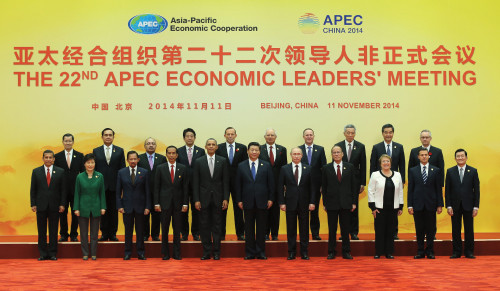

ONE BIG FAMILY: APEC economic leaders pose for a group photo during their annual meeting in Beijing on November 11 (YAO DAWEI)
"FTAAP," "connectivity" and "innovation" were among the buzzwords during the Asia-Pacific Economic Cooperation (APEC) Economic Leaders' Week (November 5-11) in Beijing and they will certainly become the keywords for the Asia-Pacific region's future development. [Special coverage]
Revolving around the theme of Shaping the Future Through Asia-Pacific Partnership, this year's APEC Economic Leaders' Meeting focused on the three major topics: advancing regional economic integration; promoting innovative development, economic reform and growth; as well as strengthening connectivity and infrastructure development.
On November 11, after their annual meeting ended, APEC economic leaders released two important documents—the 22nd APEC Economic Leaders' Declaration: Beijing Agenda for an Integrated, Innovative and Interconnected Asia-Pacific and the Statement on the 25th Anniversary of APEC: Shaping the Future Through Asia-Pacific Partnership.
"The two documents further define the directions, goals and actions of the region's development and mark the beginning of a new era of Asia-Pacific cooperation," Chinese President Xi Jinping told the media at a press conference after the 22nd APEC Economic Leaders' Meeting closed.
The latter is a commemorative statement—the first of its kind in the history of APEC—which "we believe will give strategic guidance to the APEC, consolidate its position and give full play to its role of leading and coordinating economic cooperation in the Asia-Pacific region," said Xi.
The 21 APEC member economies have a combined population of 2.8 billion, or 40 percent of the world's total, generate 57 percent of the world's GDP and contribute 48 percent to global trade. Facing the uneven recovery of the world economy, the Asia-Pacific has entered a new stage of development with both new opportunities and new challenges.
Xi said that APEC economic leaders have reached consensus that economic integration is the driving force behind the region's sustained strong growth in the long term.
Facilitating FTAAP
The APEC economic leaders endorsed a roadmap for promoting the Free Trade Area of the Asia-Pacific (FTAAP) process. This is "a historic step we took toward realizing the FTAAP," marking the official launch of the process and demonstrating the confidence and determination of APEC members in advancing regional economic integration, said Xi.
The decision will raise integration to a new and higher level, benefit economies at various development stages across the Pacific Ocean and inject new energy into the growth of the region and all APEC member economies, the Chinese President said.
According to the APEC economic leaders' declaration, APEC member economies will begin studying issues surrounding the FTAAP and will submit recommendations by the end of 2016.
"APEC has been called the 'incubator' of an FTAAP for years," said Gao Hucheng, China's Commerce Minister at a press conference after the APEC Ministerial Meeting adopted the roadmap on November 8. "Launching the joint strategic study on FTAAP issues marks a progression of the APEC's role from being an 'incubator' to being a facilitator for the FTAAP."
Copyright ©1999-2018
Chinanews.com. All rights reserved.
Reproduction in whole or in part without permission is prohibited.